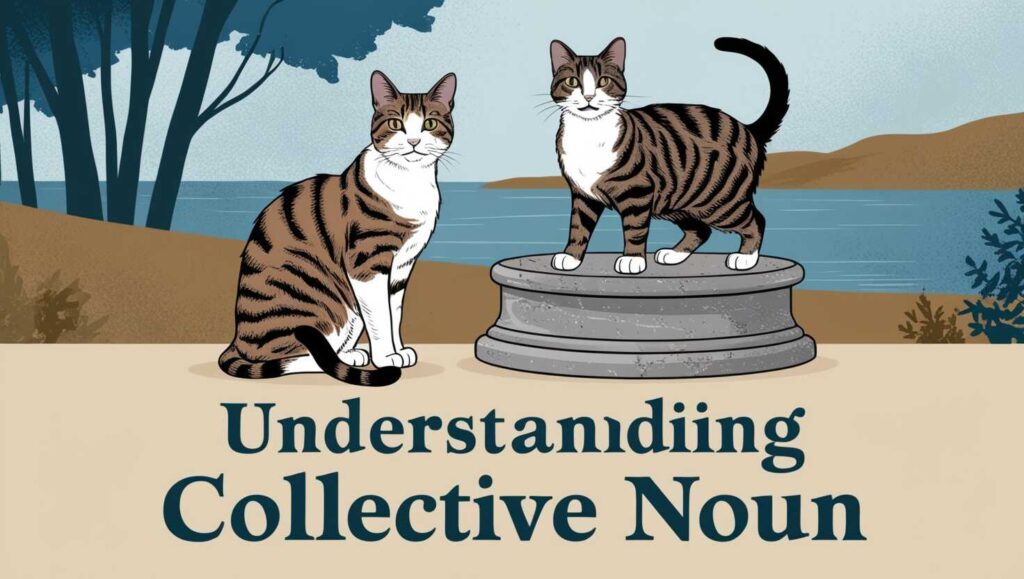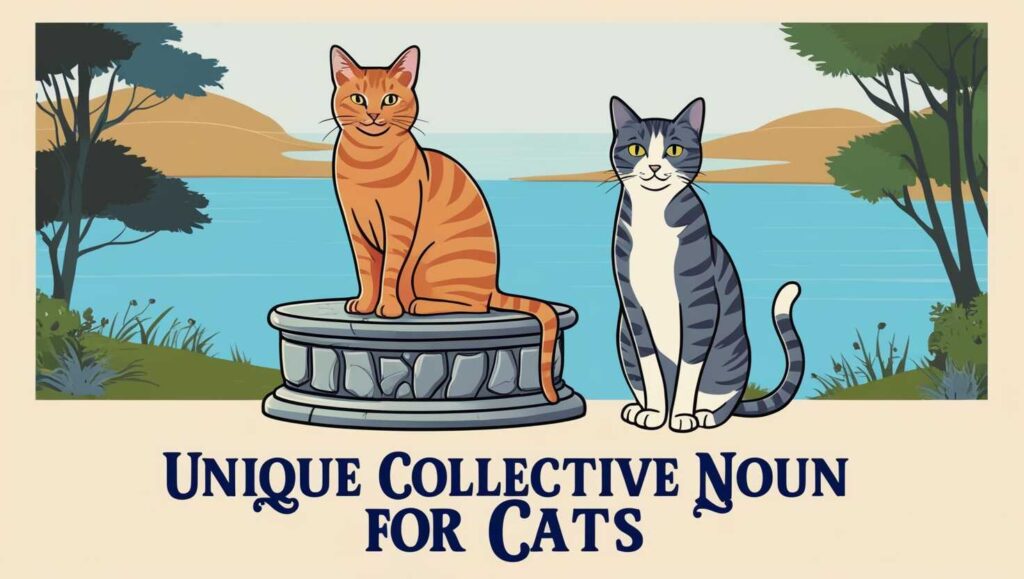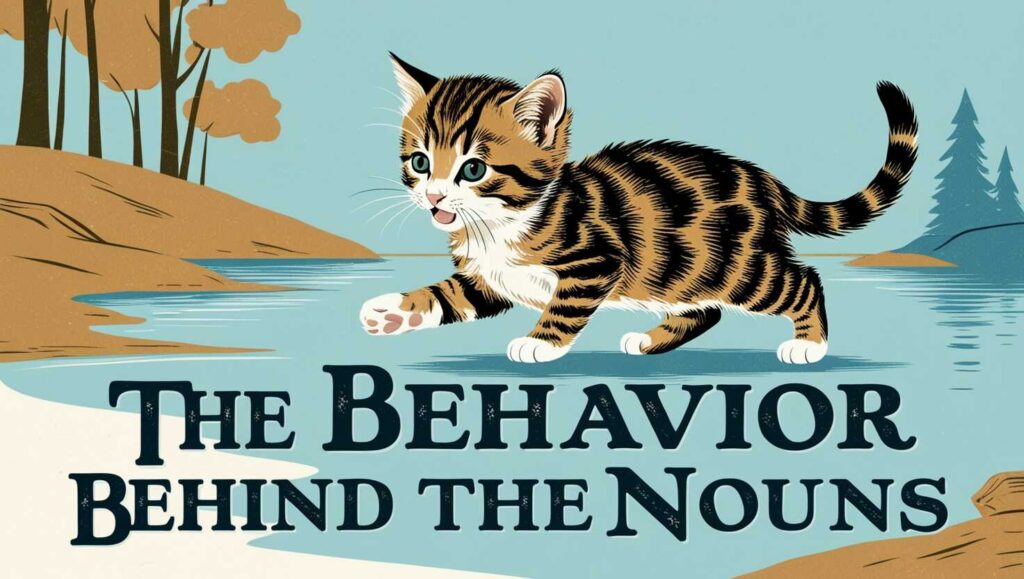Collective noun for cats offer a captivating glimpse into the marvelous world of these elegant creatures. From their graceful movements to their independent demeanor, cats have won the hearts of countless admirers. Interestingly, language plays a crucial role in how we describe these fascinating beings.
Collective nouns not only enhance our vocabulary but also reveal valuable insights into their behaviors and characteristics. In this article, we’ll embark on a journey to explore the meanings behind these unique terms and delve deeper into what they signify about feline groups.
Understanding Collective Noun

Before we dive into the specific terms, let’s clarify what a collective noun for cats actually is. Collective nouns refer to a group of animals or things treated as a single entity. For example, when we say “a herd of elephants,” we’re using a collective noun to describe a group.
The Role of Collective Nouns
Collective nouns enhance our understanding of animal behavior. They encapsulate the essence of the group in a single word, giving us a glimpse into their social structures and interactions. This is especially true in the cat universe, where these terms reflect the distinctive traits of our adorable and a source of endless fun companions.
Importance of Collective Nouns
- Language Enrichment: Collective nouns add richness to our language.
- Cultural Significance: Many of these terms stem from historical and cultural references.
- Behavioral Insights: They provide a view of how different species interact within their groups.
Unique Collective Noun for Cats

| Collective Noun | Description | Example Sentence |
|---|---|---|
| A Clowder of Cats | A group of domestic cats | “At the rescue center, we spotted a clowder of playful kittens.” |
| A Pounce of Cats | A playful term emphasizing agility | “The children’s laughter echoed as they watched a pounce of cats.” |
| A Destruction of Wild Cats | A dramatic term for a group of wild cats | “The wildlife photographer documented a destruction of wild cats.” |
| A Kindle of Kittens | Specifically refers to a group of kittens | “The shelter received a call about a kindle of kittens needing a home.” |
| A Glaring of Cats | Describes cats observing something intently | “A glaring of cats sat by the window, captivated by the fluttering birds.” |
| A Cat Cluster | A small gathering of cats | “The cat cluster gathered around the warm sunlight.” |
| A Cat Pack | A group of feral or wild cats | “The cat pack roamed the streets in search of food.” |
| A Cat Gathering | A generic term for any assortment of cats | “During the event, a cat gathering formed in the park.” |
Let’s explore some unique terms that describe groups of cats. Each of these collective nouns has its own flavor and reflects the traits of these elegant creatures.
A Clowder of Cats
The term “clowder” is one of the more common collective nouns used for cats. It refers to a group of domestic cats, and its origin is somewhat mysterious, possibly derived from the Middle English word “clodder,” which means to be in a lump.
- Context: You might hear “clowder” used when referring to a gathering of cats in a household or a cat café.
- Example: “At the rescue center, we spotted a clowder of playful kittens tumbling over each other.”
A Pounce of Cats

“Pounce” is a playful term that perfectly encapsulates a group of cats in action. This collective noun emphasizes their agility and playful nature.
- Context: The term can be used humorously when discussing a group of cats during playtime.
- Example: “The children’s laughter echoed as they watched a pounce of cats springing onto the couch.”
A Destruction of Wild Cats
This dramatic term captures the untamed essence of wild cats. It reflects their fierce behavior and potential for chaos when they gather.
- Context: Often used in wildlife documentaries or discussions about feral cat populations.
- Example: “The wildlife photographer documented a destruction of wild cats prowling through the grasslands.”
A Kindle of Kittens

The term “kindle” specifically refers to a group of kittens. This collective noun highlights the innocence and charm of these young felines.
- Context: Used primarily in conversations about breeding or shelters with litters.
- Example: “The shelter received a call about a kindle of kittens that needed a foster home.”
A Glaring of Cats
This intriguing term describes a group of cats when they are observing something intently. The word “glaring” evokes a sense of focus and intensity.
- Context: Ideal for situations where cats are fixated on a bird outside the window.
- Example: “A glaring of cats sat by the window, captivated by the fluttering birds.”
Other Notable Terms
- A Cat Cluster: This term refers to a small gathering of cats, often seen cuddling or resting together.
- A Cat Pack: Used for groups of feral or wild cats, highlighting their pack-like behavior.
- A Cat Gathering: A more generic term that can apply to any assortment of cats.
Exploring Collective Noun for Domestic Cats
Exploring collective nouns for domestic cats reveals the playful and social dynamics of these beloved pets. Terms like “clowder” and “kindle” highlight not only their group behavior but also the affectionate bonds they form with each other.
Understanding these unique terms enriches our appreciation for the charming lives of our feline companions.
| Collective Noun | Meaning | Example in Use |
| Clowder | A group of domestic cats | “Our neighborhood has a large clowder of domestic cats.” |
| Litter | A group of kittens born to the same mother | “Our family cat had a litter of kittens last night.” |
| Kindle | Another term for a group of kittens | “The shelter just received a kindle of adorable kittens.” |
| Glaring | A group of unfamiliar or hostile cats | “A glaring of stray cats appeared near the alley.” |
| Cluster | A group of domestic cats, often lounging together | “A cozy cluster of cats curled up by the fireplace.” |
The Behavior Behind the Nouns

Understanding these collective nouns allows us to peek into the conduct and traits of cats. Each term reflects specific behaviors and social dynamics within feline groups.
Social Structures in Domestic Cats
Domestic cats are often solitary creatures, but they can form social bonds in certain environments.
- Family Units: A clowder may consist of a mother and her kittens, or multiple adult cats cohabiting peacefully.
- Hierarchy: Within a clowder, cats may establish a hierarchy, where one or two individuals take on leadership roles.
Wild Cats and Their Group Dynamics
In the wild, cats exhibit different behaviors. The term “destruction of wild cats” captures the unpredictable and fierce nature of these animals.
- Hunting Packs: Wild cats often hunt in groups, showcasing teamwork and strategy.
- Territorial Behavior: Many wild cats are territorial and will defend their areas against intruders.
Insights from Cat Behavior Studies
Studies have shown that group living can influence behavior and social structures. Cats in a cat kingdom can experience:
- Enhanced Learning: Cats can learn from one another when in groups, particularly about hunting techniques and social interactions.
- Stress Reduction: Some studies suggest that social interactions among cats can lower stress levels.
Cultural References and Fun Facts
Collective nouns for cats also pop up in literature, pop culture, and folklore. Here are a few notable mentions:
Collective Nouns in Literature
- T.S. Eliot’s “Old Possum’s Book of Practical Cats”: This classic poem collection refers to various whimsical collective terms for cats, adding charm to the narrative.
- Children’s Books: Many children’s stories employ playful collective nouns to engage young readers.
Fun Facts About Cats
- Lifespan: Domestic cats can live up to 15 years or more, especially with good care.
- Communication: Cats communicate through a combination of vocalizations, body language, and even collective behaviors, like purring when together.
Frequently asked questions
What is a fleet of cats called?
A fleet of cats is often referred to as a “clowder.”
Is a group of cats called a pride?
No, a group of cats is not called a pride; that term is used for lions.
What do you call a community of cats?
A community of cats can be referred to as a “clowder” or a “glaring,” depending on the context.
What are cats called feline?
Cats are called felines, which refers to their family, Felidae.
What is a group of big cats called?
A group of big cats is commonly called a “coalition,” especially in the case of lions.
Conclusion
The exploration of the collective noun for cats reveals much about these intriguing animals. For instance, from the playful “pounce” to the intense “glaring,” each term offers a unique lens through which we can appreciate the behaviors and characteristics of our feline friends. Moreover, these nouns not only describe the animals but also capture the essence of their personalities. In addition, the variety of terms showcases the multifaceted nature of cats, reflecting their playful, independent, and sometimes mysterious demeanor. Therefore, understanding these collective nouns enhances our appreciation of cats as captivating creatures.
By using these distinctive words, we not only enrich our language but also deepen our understanding of the complex social structures that exist within the feline world. As you observe your own cats or those in shelters, consider how these collective terms can enhance your appreciation for their cute and inspiring antics.

Ava Rose, the creator of PhrasesPulse, is an expert in English grammar with years of experience. She is dedicated to simplifying complex grammar rules and exploring the richness of English phrases. Through her insightful posts, Ava aims to help learners of all levels enhance their understanding of the language and communicate more effectively. Her passion is making grammar approachable and enjoyable for everyone.







